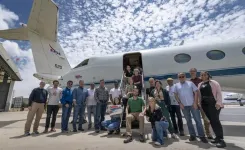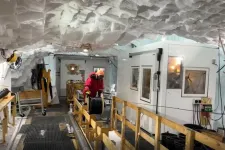Multinational research project shows how life on Earth can be measured from space
2025-02-06
(Press-News.org)
Measurements and data collected from space can be used to better understand life on Earth.
An ambitious, multinational research project funded by NASA and co-led by UC Merced civil and environmental engineering Professor Erin Hestir demonstrated that Earth’s biodiversity can be monitored and measured from space, leading to a better understanding of terrestrial and aquatic ecosystems. Hestir led the team alongside University of Buffalo geography Professor Adam Wilson and Professor Jasper Slingsby from the University of Cape Town on BioSCape, which collected data over six weeks in late 2024.
Two NASA aircraft and one South African aircraft flew over South Africa’s Greater Cape Floristic Region —one of the most biodiverse places on the planet — to collect ultraviolet, visual, thermal and other images. That data, combined with field work by the large team of scientists from the United States and South Africa, provides a comprehensive look at the region's biodiversity, or life systems.
“This was NASA’s first ever biodiversity-focused campaign,” Hestir said. “We successfully hit all our measurement targets, and the data collected are contributing to novel techniques and methods to be able to monitor biodiversity from space across the globe. It’s a lot of exciting science.”
Wilson said BioSCape showed what scientists working across continents can do, and he hopes it can be replicated elsewhere.
“Over just six weeks, more than 160 scientists from around the world came together to collect and analyze data across terrestrial, marine and freshwater ecosystems in one of the world’s biodiversity hotspots.”
The team recently published two papers on BioSCape, in the publications Nature Reviews Biodiversity and npj Biodiversity.
Once researchers proved they could collect the data they were looking for from planes, NASA could use the novel combinations of instruments to expand the effort worldwide.
“It’s very expensive to launch a satellite into space,” Slingsby explained. “You have to be certain it will achieve its mission before taking that step. That’s why we begin with airborne studies — they serve as a critical proving ground. If we can successfully gather data from a plane, it brings us one step closer to understanding how to achieve the same from space.”
The team chose the Greater Cape Region of South Africa because it’s home to “astonishing levels of biodiversity, wicked conservation challenges and a well-developed and progressive biodiversity research and conservation community,” they wrote.
The tools they developed helped them examine shifting community composition; ecosystem disturbance, resilience and recovery; and ecosystem function and nature’s contributions to people.
Addressing biodiversity loss is a global priority and there is a clear need to improve scientists’ ability to map and monitor change. The researchers made the data freely available to scientists and the public around the world. Their hope is that the methods they developed and insights they found will help shape new technologies for measuring land and sea ecosystems and ultimately improve biodiversity conservation.
They are excited to see what comes next.
“BioSCape is building technical capacity in South Africa and we hope to prepare the community to take advantage of NASA’s advanced and freely available satellite imagery to improve conservation,” said Anabelle Cardoso, the science team manager.
“In a year from now we will have new findings and better insights,” Hestir said, “advancing cutting-edge technology so we can measure life on Earth from space.”
END
[Attachments] See images for this press release:

ELSE PRESS RELEASES FROM THIS DATE:
2025-02-06
Embargoed for release: Thursday, February 6, 2025, 2:00 PM ET
Key points:
Comprehensive genetic mapping of Plasmodium knowlesi, a zoonotic parasite that causes malaria, has revealed the genes required for malaria infection of the blood, and those driving drug resistance.
By identifying specific druggable targets and determinants of resistance, the map provides insights that could help the development of new therapeutics.
Boston, MA—A new, comprehensive map of all the genes essential for blood infections in Plasmodium knowlesi (P. ...
2025-02-06
In brief:
• In Greenland, an international team of researchers led by ETH Zurich has discovered that countless tiny ice quakes take place deep inside ice streams.
• These quakes are responsible for the fact that ice streams also move with a continuous stick-slip motion and not only like viscous honey as previously considered.
• The researchers recorded seismic data from inside the ice stream using a fibre-optic cable in a 2,700-metre deep borehole.
The ...
2025-02-06
Whale song can be as efficient as – and, in some cases, more efficient than – human communication, according to a new study in Science Advances. Meanwhile, new unrelated research in Science further investigates whale song’s adherence to a universal linguistic law, as observed in recordings of humpback whales.
Natural selection favors the pithy over the longwinded. For example, yelling “Duck!” is faster and far more effective than shouting “Be careful, there is an incoming projectile, and you need to move out of the way!” ...
2025-02-06
Researchers have uncovered a neural mechanism in the brains of mice that enables them to override instinctive fear responses; dysfunction in this mechanism may contribute to inappropriate or excessive fear responses, they say. According to the findings, targeting these circuits could offer new therapeutic avenues for treating fear-related disorders like post-traumatic stress disorder and anxiety. Fear responses to visual threats, such as escaping from an approaching predator, are critical instinctive reactions for survival and are ...
2025-02-06
The hormone adrenomedullin disrupts insulin signaling in blood vessel cells, contributing to systemic insulin resistance in obesity-associated type 2 diabetes, according to a new study. Blocking adrenomedullin’s effects restores insulin function and improves glucose control in a mouse model, suggesting a potential new target for treating obesity-related metabolic disease. Diabetes is a leading global cause of illness, mortality, and healthcare expenditures, with most cases stemming from obesity-induced insulin resistance and type 2 diabetes mellitus. Insulin resistance primarily ...
2025-02-06
In this Special Issue of Science, 3 Reviews and a Policy Forum highlight research on Earth’s frozen places – from the Arctic to the Antarctic – and how it’s changing due to climate change and the geopolitical challenges this important work faces. In the first Review, Julienne Stroeve and colleagues provide a preview of what the Arctic region may look like in a warmer world. Without stronger climate action, global temperatures are set to rise +2.7°C above preindustrial levels, ...
2025-02-06
Researchers at the Sainsbury Wellcome Centre (SWC) at UCL have unveiled the precise brain mechanisms that enable animals to overcome instinctive fears. Published today in Science, the study in mice could have implications for developing therapeutics for fear-related disorders such as phobias, anxiety and post-traumatic stress disorder (PTSD).
The research team, led by Dr Sara Mederos and Professor Sonja Hofer, mapped out how the brain learns to suppress responses to perceived threats that prove ...
2025-02-06
Known for their powerful punch, mantis shrimp can smash a shell with the force of a .22 caliber bullet. Yet, amazingly, these tough critters remain intact despite the intense shockwaves created by their own strikes.
Northwestern University researchers have discovered how mantis shrimp remain impervious to their own punches. Their fists, or dactyl clubs, are covered in layered patterns, which selectively filter out sound. By blocking specific vibrations, the patterns act like a shield against self-generated shockwaves.
The study will be published on Friday (Feb. 7) in the journal Science.
The findings someday could be applied to developing ...
2025-02-06
A corn plant knows how to find water in soil with the very tips of its roots, but some varieties, including many used for breeding high-yielding corn in the U.S., appear to have lost a portion of that ability, according to a Stanford-led study. With climate change increasing droughts, the findings hold potential for developing more resilient varieties of corn.
The study, published in the journal Science, uncovers genetic mechanisms behind root “hydropatterning,” or how plant roots branch toward water and avoid dry spaces in soil. In particular, the researchers ...
2025-02-06
Humpback whale song is a striking example of a complex, culturally transmitted behavior, but up to now, there was little evidence it has language-like structure. Human language, which is also culturally transmitted, has recurring parts whose frequency of use follows a particular pattern. In humans, these properties help learning and may come about because they help language be passed from one generation to the next. This work innovatively applies methods inspired by how babies discover words in speech to humpback whale recordings, uncovering the same statistical structures found in all human languages. It reveals previously undetected structure in ...
LAST 30 PRESS RELEASES:
[Press-News.org] Multinational research project shows how life on Earth can be measured from space





